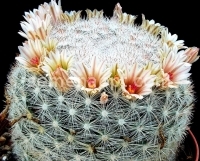
-
- Notice
- No new notifications
-
- Messages
- See all notifications
-
18
- The cart
In the basket 0
in the amount of 0 RUB
- Go to basket
Vegetable seeds Flower seeds Grapes (plants) Mushrooms Agrochemicals
|

|
|
  
|
Motherland - Mexico (San Luis Potosi) . Stem initially spherical, stretches with age, pale bluish-green, 14 cm in diameter, sometimes kustyaschiysya, cylindrical nipples, with aksily bristles 7long with the nipple; radial studs 50, a length of 9 cm, they are thin, white, central spines 8 - 12, the length of 4 - 7 mm, are acicular, white, brown tips, flowers 2 cm long, 1.5 cm diameter, off-pink with white border; red fruits . growing slowly . Genus Mammillaria Haw . - Mammillaria - the most numerous genus of the family Cactaceae . Hehas 350 species and 98 varieties . Rod is divided into 3 sections hydor-hilum - with watery juice, galaktos-chylos - with milky juice and hydro sub-chymos, whose sap is available only in the central vessels . Depending on the shaped nipple studs and stem, and flowers and other quantities, these attributes are divided into more sections na sub groups andsubgroup . Appearance Mammillaria, their flowers, thorns and pubescence unusually varied . A distinctive feature of the genus is the lack of ribs instead of which stem of the plant is covered with papillae, and the special structure of the areola: it is divided into two parts - one carrying the spikes, is at the end of the papilla, another - and vegetative -aksile is in (the depression between the papillae) . The flowers appear from last year's axilla around the top . After flowering, the fruit is formed immediately, it gradually emerges from the axilla . Plant of the genus Mammillaria culture mostly unpretentious . In the summer they need moisture and the sun (with shading from strong heat), in the winter - dry and coldcontent at + 8, + 10 ° . Some authors (Pazhout, etc. . . ) Identify groups Mammillaria the general background that creates a coating of stem pubescence . Very beautiful white (M . Bocasana, M . Kandnda, M . Plumosa and M . hahniana) and yellow Mamillaria (M . elongata, especially the kind of Stella-aurate, M . Pringles, M . goal-ziana and others)pubescence which hairs, spines and bristles often completely covers the buds on the stem and looks very impressive. White Mamillaria grow in mountainous areas of central and northern Mexico on limestone and chalk cliffs . They no longer need other cacti in the light of the sun and require supplements lime in the soil .
| SPECIFICATIONS | |
|---|---|
| Description | |
| For decoration | appearanceMammillaria, their flowers, thorns and pubescence unusually diverse |
| Grows | growing slowly , |
| Motherland | Mexico (San Luis Potosi) |
| Rod | Mammillaria Haw . , has 350 species and 98 varieties , |
| Flowers | |
| Color | off-pink withwhite border |
| Diameter | flowers 2 cm long, 1.5 cm in diameter |
| Fruits | |
| Color | red |
| Features | after flowering fruit is formed immediately, it gradually emerges from aksily |
| Plant | |
| Flowers | the last year of the axilla appear around the top |
| Spikes | |
| Per stem | central spines more than 50 long up to 9 cm, they are thin, white |
| Features | central spines 8 - 12, a length of 4 - 7 mm, they are needle-shaped, white, with brown ends |
| Trunk | |
| Diameter | 14 cm |
| Areola | it is divided into two parts - one carrying the thorns, the other - and vegetative - located in the axilla |
| Form | initially spherical, with age is extended, cylindrical nipples; aksily with 7 setae long with nipple |
| Color | light -golubovato green |
| Branching | sometimes bushy |
acanthocalycium backbg .
aporocactus lem
astrophytum lem .
austrocylindropuntia backbg
aylostera speg .
brasilicactus backbg .
brasiliopuntia (k . sch . ) berg .
cephalocerciis pfeiff .
cereus mill .
cleistocactus lem .
cliamaecereus br . et r .
copiapoa br . et r .
coryphantha (eng . ) lem .
dolichothele (k . sch . ) br . et r
echinocactus lk . et o .
echinocereus eng .
echinofossulocactus lawr .
echinopsis zucc .
epiphiliopsis berg .
epiphillum haw .
eriocactiis backbg .
eriocereus (berg . ) ricc .
espostoa br . et r .
ferocactus br . et r .
frailea br . ef r .
gymnocaclus backbg .
gymnocalycium pfeiff .
hamatocactus br . et r
hatiora br . et r .
helianthocereus backbg .
heliocereus (berg . ) br . et r .
horridocactus backbg .
hylocereus br . et r .
lepismium
lobivia br . et r .
loxanthocereus backbg .
mammillaria haw
matucana br . et r .
mila br . et r .
myrtillocactus cons .
neochilenia backbg .
neoporteria br . et r .
notocactus (k . sch . ) berg .
opuntia (tournef . ) mill .
oreocereus (berg . ) ricc .
parodla speg .
peireskia (plum . )
peireskiopsis br . et r
pseudolobivia backbg .
rebutia k . sch .
rhipsalis gartn .
selenicereus (berg . ) br . et r
tephrocactus lem .
trichocereus (berg . ) ricc .
weingartia word .
zygocactus k . sch .
Enter your information
To recover the password
Forgot password? Enter your e-mail
Registration for new users
Enter your details: